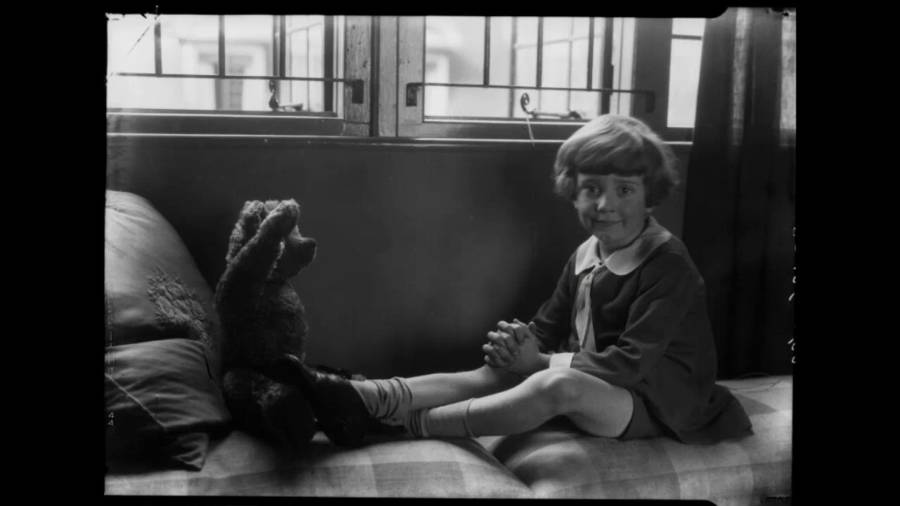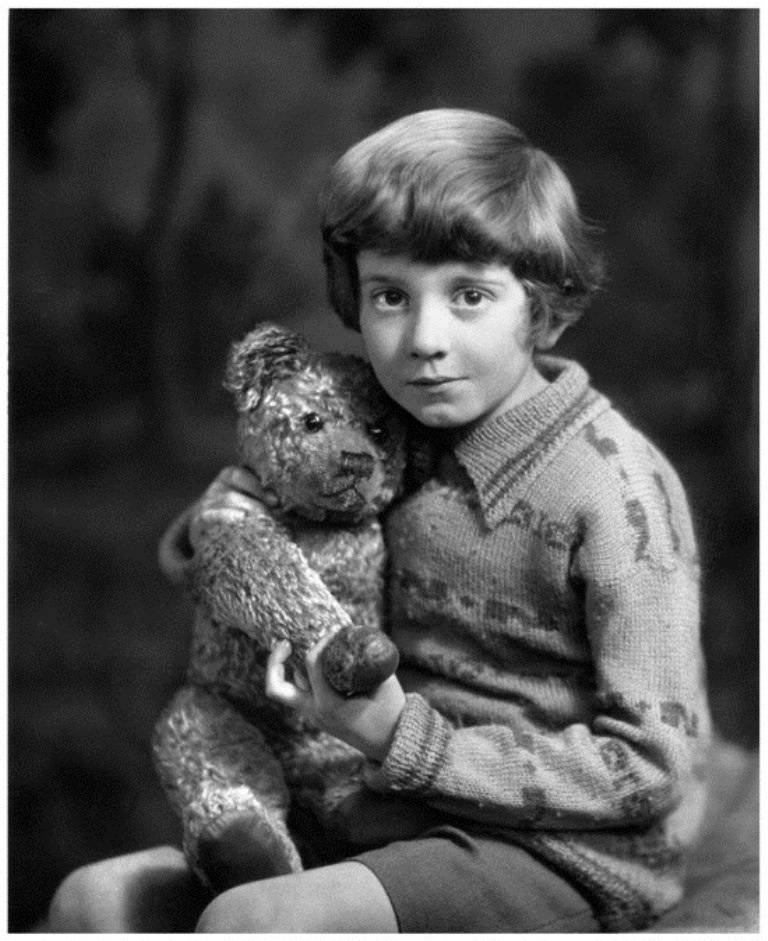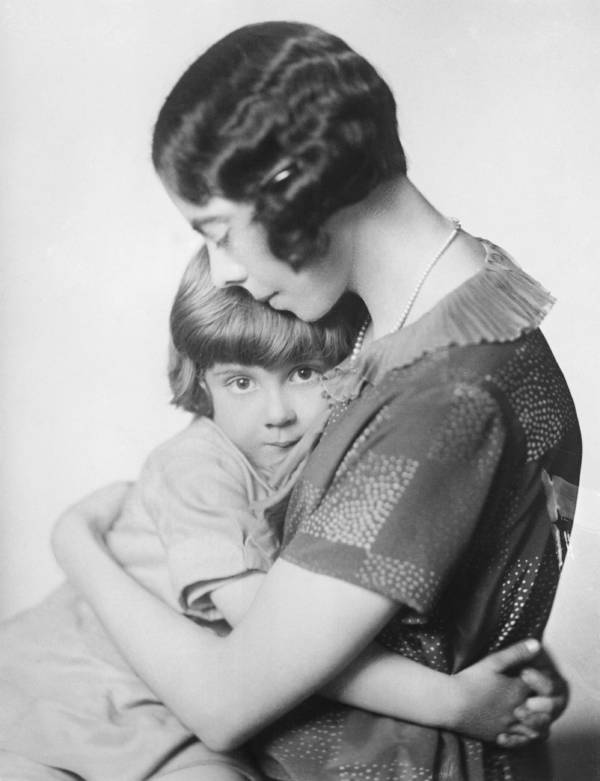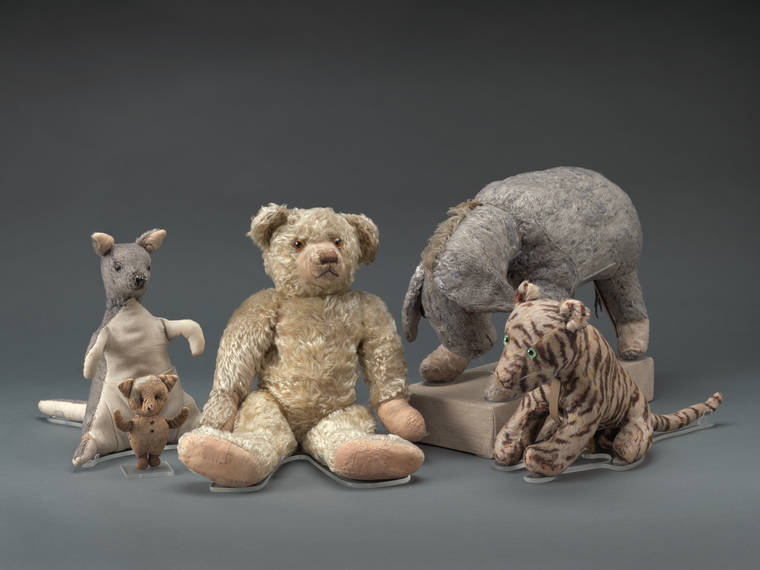The house at Pooh Corner was not a magical place for the real Christopher Robin Milne who was overshadowed by his fictional namesake.

Andrew Scott/YouTubeA young Christopher Robin Milne with Winnie-the-Pooh.
A. A. Milne’s classic tales of the loveable bear Winnie-the-Pooh and his loyal human pal, Christopher Robin, have enchanted children around the world since it was first published in 1926. Unfortunately for the real Christopher Robin Milne, the author’s young son, those stories brought little more than misery.
Christopher Robin’s Charmless Boyhood
A.A. Milne’s stories suggested that the author himself must have had a profound appreciation for and understanding of what it meant to be a child. It’s hard not to imagine the real Christopher Robin and his real-life teddy bear named Winnie-the-Pooh as the happiest little boy who ever lived.
But the real Christopher Robin Milne’s life wasn’t as magical as the imaginary little boy he inspired. In reality, when A.A. Milne was with his real son, he didn’t even know where to begin. “Some people are good with children. Others are not,” Christopher Robin Milne has said. “It is a gift. You either have it or you don’t. My father didn’t.”
It’s not how we like to imagine Milne, but it’s a description that Milne himself has never denied. He once even told an interviewer, “I am not inordinately fond of [children]. … I have certainly never felt in the least sentimental about them – or no more sentimental than one becomes for a moment over a puppy or a kitten.”
But he wrote for himself a “dream son” instead, one who didn’t require real-world attention. Christopher Robin Milne described how his father was an absent figure, locked in his office, writing about his imaginary son who would come to overshadow the real boy.
Because the two were so distant, the stories of Winnie-the-Pooh didn’t come from a father bonding with his child. Instead, A. A. Milne learned what his son was doing through the odd report from his wife and the boy’s nanny. According to Christopher Robin, “It was my mother who used to come and play in the nursery with me and tell him about the things I thought and did. It was she who provided most of the material for my father’s books.”
When his father wasn’t home, Christopher Robin remembered how he spent much of his time hiding out at the local gentlemen’s club, the Garrick, of which he was a member.
As Winne-the-Pooh became an overnight sensation the real Christopher Robin Milne became, at just seven-years-old, the face of an international publicity campaign.
Exploited For Fame By His Father

Wikimedia CommonsChristopher Robin Milne, circa 1925.
Christopher Robin posed for photographs with his father and his bear, sang songs from his father’s books for crowds of hundreds, and even played the dream son’s role in audio recordings of the books.
Christopher Robin has reported that he “quite liked being famous,” until he turned eight and was sent off to boarding school. There, he was bullied relentlessly. His classmates would yell out “Where’s your teddy bear?” when he passed by, or else chant the poems his father had written. Often, the bullying would even get physical – and, by the time Christopher Robin turned 13, he was taking boxing lessons to learn how to defend himself.
He was a skinny, girlish boy who had been immortalized in literature in his six-year-old form and then surrounded by a throng of young boys who were jealous of his fame.
If boarding school was hard for Christopher Robin Milne, adulthood was even harder. He was the Christopher Robin, the hero of a story that was only getting more popular as he grew older. Much was expected of him from both his father and the world that revered him, which made it all that much harder when he failed.
He outright refused to profit from his father’s work but he was not bringing much money home himself as after college, Christopher Robin found himself making ends meet in odd jobs.
Christopher Robin has recalled how this period in his life solidified the resentment and abandonment he felt from his father. He said that,”It seemed to me, almost, that my father had got to where he was by climbing upon my infant shoulders, that he had filched from me my good name and had left me with nothing but the empty fame of being his son.”
The Milne Family Separation

Getty ImagesDaphne de Selincourt, wife of A.A. Milne, huggs her son Christopher Robin in 1926.
The only comfort in his life at this time, Milne has said, was his love Lesley de Selincourt, who was also his first cousin.
His parents were less than thrilled, partly because Lesley was the daughter of Christopher’s uncle, who was estranged from his sister, Daphne Milne. His family did everything they could to break them apart.
Christopher Robin’s parents would completely cut him out of their life when he said in an interview with the press that his parents were cold and detached. He was working on a book, he told the reporter, that would tell the world what it was really like to grow up as the son of A. A. Milne – and that was no fairy tale.

J. Wilds/Keystone/Getty ImagesChristopher Robin Milne, and his fiancee Lesley de Selincourt, April 21, 1984.
His mother was so furious that she had a statue of her son torn down and buried in a hole under the ground.
His father would rarely talk to him again; his mother wouldn’t at all. Even on her deathbed, when Christopher Robin begged for the chance to speak to his mother one last time, she turned him down. In the last fifteen years of her life, he only saw his mother once.
He would go on to marry Lesley anyway and the two had a daughter, Clare, who has cerebral palsy. Christopher and his wife owned and operated a small bookshop in Devon and enjoyed a happy and quiet life together. Though he never reconciled with his parents, Christopher Robin was able to through his trials in three volumes of autobiography with a loving wife and daughter at his side.
In fact, just before he died, Christopher reported that he had come to terms with his love-hate relationship with Winnie-the-Pooh, “believe it or not, I can look at those four books without flinching. I’m quite fond of them really.”
The Christopher Robin Movie
Last year, a fictionalized and whimsical retelling of Christopher Robin and Pooh hit the silver screen starring Ewan McGregor as the title character. Though well-received, the movie is not an accurate depiction of Christopher’s Robin childhood or adulthood.
Goodbye Christopher Robin, released the year before, posits a more historical account of Milne’s relationship with his son, Christopher, though still not without its faults.
For the complete and true story of the fraught child and adulthood, it is probably better to turn to Christopher Robin’s autobiographies.
“Goodbye, Christopher Robin”

New York Public LibraryThe real Winnie-the-Pooh, Piglet, Kanga, Eeyore and Tigger, inside of the New York Public Library.
Christopher Robin and Winne-the-Pooh were nearly reunited in 1987, 40 years after his father had given the forgotten teddy bear away. The bar’s owner, E. P. Dutton, offered him the chance to take his bear back, but Christopher Robin turned him down.
There was a public outcry of heartbreak when Christopher Robin allowed his bear to be donated to the New York Public Library. But to Christopher Robin, this was nothing more than a grown man giving away a teddy bear he hadn’t touched since he was a little boy.
“I like to have around me the things I like today, not the things I once liked many years ago,” he once said. “My toys were and are to me no more than yours were and are to you. I do not love them more because they are known to children in Australia or Japan.”

Wikimedia CommonsChristopher Robin Milne with his father, A. A. Milne, and his bear. Circa 1925.
In his father’s stories, Christopher Robin held Winnie-the-Pooh’s hand before going off to boarding school and begged him: “Pooh, promise you won’t forget about me, ever. Not even when I’m a hundred.”
The real Christopher Robin wasn’t quite a hundred yet – only sixty-four. But it had been just how the story had promised. He’d gone off to boarding school, and when he’d come back, he wasn’t quite the same.
His father had promised that there would be an enchanted place on the top of the forest where a little boy and his bear will always be playing. But to Christopher Robin, it was a place that only existed in the hearts of other children.
The real boy had grown up. He’d stopped playing, and he didn’t need his bear anymore. Christopher Robin says it’s foolish to be sad about the death of a boy who was nothing more than his father’s dream, “It’s been something of a love-hate relationship down the years, but it’s all right now.”
Next up, learn about the legend behind Mulan and the dark fairy tales that inspired your favorite Disney classics.





